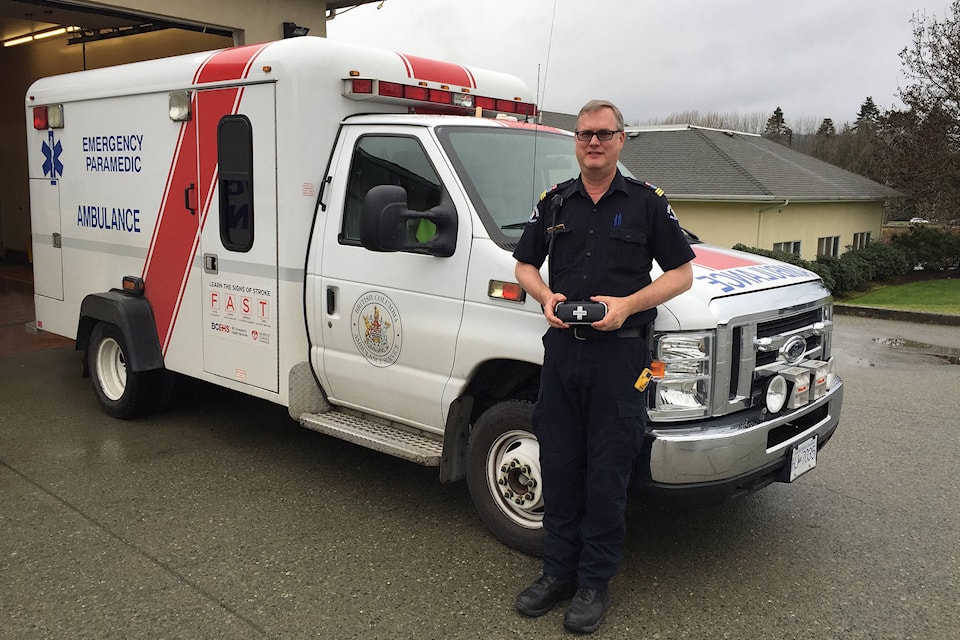BY MIKE YOUDS
Special to the News
With the sort of calm reserve expected from his professional background, Mark Lacroix lays out the challenge confronting Port Alberni’s Community Action Team (CAT), a group set up last year to save lives in the face of an unrelenting health emergency.
“We want to introduce ourselves and share some of our successes,” said Lacroix, CAT’s co-ordinator and a former B.C. Ambulance Service paramedic. “There is more work that needs to be done.”
That would be understatement in the case of the opioid/fentanyl crisis, which has claimed more than 1,400 lives in B.C. in each of the last two years. Lacroix believes the death count, though still high, has plateaued.
“We’re viewing this as a positive change, the numbers have been going up for so long. Now, the real challenge, how do we start to bring those numbers down,” he said. “The overdose deaths are occurring among people using opiates alone in private residences. There’s never been a fatality at the overdose prevention site in the Alberni Valley.”
Last year, the province allocated $1.5 million to establish CATs in 18 communities provincewide, including Port Alberni. If overdose prevention sites are the front-line lifesavers, CATs are the champions of harm reduction.
“We try to keep people alive long enough so that they can get to a place where they want help,” Lacroix said. “We’re doing everything we can to temporize this and keep people alive.”
As he points out, the fatalities are not occurring at overdose prevention sites such as the one on Third Avenue, set up three years ago as the front line of defence in the crisis.
Deaths continue at alarming rates mainly because people are consuming drugs at home and alone, often with no help available if they get into trouble.
Six of seven overdoses in the city last year took place in private residences. Overall, the figure is 90 percent of overdose deaths in private homes. Of the fatal doses, 87 percent contained fentanyl.
That critical isolation factor complicates efforts to curb fatalities. Lacroix believes they have at their disposal a powerful tool, an effective way to overcome the barrier. Overcome the stigma associated with drug use and you overcome the barrier, he said.
“As the Community Action Team, we view stigma as the main barrier to change.”
They encounter attitudes in the community, often expressed in social media comments that vilify drug users.
“It’s a health problem,” he said. Knowing that it’s systemic and treatable is essential to addressing the problem. “In order to make a difference and decrease stigma, you need to know the facts, not the myths. You need to be aware of your attitudes and behaviours. Choose your words carefully. Educate others. Focus on the positive. Support people and include everyone.”
To that end, CAT invites all to a public information session Jan. 31, 6:30 p.m., at the Best Western Plus Barclay Hotel (4277 Stamp Ave.).
“We need to change our perceptions, get knowledgeable,” Lacroix said.
His CAT teammates — representatives of a dozen organizations including the city and government health agencies and “PWLEs,” people with lived experience — plan to home the case for harm reduction strategies.
“It’s an opportunity to increase the conversation and start a dialogue,” said Deb Hamilton, support worker who manages Alberni Drug and Alcohol Prevention Service. “It’s one of the things I’ve been thinking about in the last few weeks. I think for all of us to keep moving forward, we have to be willing to get uncomfortable.”
Moving forward means removing the No. 1 barrier, she said: “The barrier is that not everybody in our community is OK in seeing addiction treated with health care and with compassion. Some people just want to see services through the criminal justice system.
“People with lived experience know that harm reduction saves lives and they know it’s not a hopeful framework of services we offer to people who are unwell. Harm reduction allows us to say, ‘You are autonomous and have the right to make decisions to keep you safe.’ ”
Hamilton is encouraged by a generational change in attitude that she sees expressed among members of her youth group.
B.C. Ambulance Unit Chief Bruce Patterson, another team member, said Port Alberni was ahead of the CAT initiative with a group that was already focused on saving lives. They’ve made a difference not only here but across the province. B.C. Ambulance crews are now equipped with Narcan kits, a practice that started here (Narcan or naloxone counters the effects of opioids and can save someone who is overdosing). The local group also had sharps containers installed at various locations in the city—collection points for discarded needles.
“There are a lot of people affected by it in the community and when we get together we realized how widespread it is,” Patterson said of the overall crisis.
Addiction isn’t confined to the street, he stressed. He lost a cousin and almost lost a niece to overdose.
